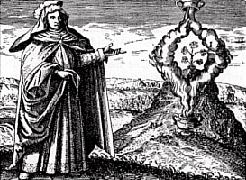ALCHEMY


Jabir ibn Hayyan and Mary the Copt
Stephen Lambden UC Merced.
Last revised 17/03/07.
Alchemy (Gr. chémeiā / chymeiā, Ar. kīmīyā) has been practised for more than two millennia and been variously defined in the light of its diverse exoteric and esoteric dimensions. Much more than a mere prelude to chemistry, it is fundamentally the science and mysticism of transformation by means of an elixir (Ar. al-iksīr), the "philosopher's stone". Islāmic alchemy was widely studied and practiced in Qajar Iran. Both the Bāb and Bahā'u'llāh utilized alchemical terminology in their writings. They revealed Tablets in response to questions about the alchemical "art". The Bāb entitled one of the chapters of his Qayyūm al-asmā', the Sūra of the Elixir (LVII). He touched upon alchemy in various major works (e.g. Kitāb-i-panj sha'n) and minor epistles (INBMC 67:304-5). Certain statements in the Bāb's writings having to do with precious stones, metals and opulent edifices, are best understood in the light of notions of alchemically perfected substances and the ideal eschatological vision. The alchemy of the Bāb is to a considerable extent rooted in the gnosis of the founders of the Persian Shi`i movement known as Kashfiyya ("Inner Disclosure") or al-Shaykhiyya (Shaykhism"), namely, Shaykh Ahmad Zayn al-Din al-Ahsā'ī (d. 1826 CE) and Sayyid Kāẓim Rashtī (d. 1259/1843) both of whom wrote a good deal about exoteric and esoteric alchemy (cf. Rashti, Dalīl al-Mutaḥayyirīn, 26).
During his two year withdrawal in Iraqi Kurdistān (1854-6) Bahā'-Allāh was reckoned by some to be "an adept in alchemy" (GPB:124). In a number of scriptural Tablets dating from the Iraq years, Bahā'-Allāh cryptically divulged some of the secrets of both theoretical and practical alchemy. In his Kitāb-i-īqān, Lawḥ-i Sarrāj and other Tablets (alwāḥ), he categorically affirms the possibility of transmuting (the base metal) "copper" into the perfected metal "gold" (see KI:101; Gl. XCVII). He also revealed a Tablet commenting upon a saying of the founding mother of Greek alchemy, Mary the Jewess (`Prophetess' or `Copt', fl. 3rd cent. CE?): `Take from the "branch" of the "Stone" not from the "root" of the "Stone"' (Ma'ida, 1:26ff).
Among the scriptural Tablets of Bahā'-Allāh known as the "Tablet of the Elixir" (Lawh-i iksīr), is one addressed to Mīrzā `Alī Muhammad Varqā' (Ma'ida 1:19f). During the late Acre (or `Akkā', "West Galilean") period of his ministry (1868-1892 CE) Bahā'-Allāh specifically forbade the practice of alchemy. He regarded the Bahā'ī revelation as the true elixir and promoting the Bahā'ī religion as the ultimate "alchemy" (Asrar al-athar 1:208; AQA 3:356f).Towards the end of his foundational and legalistic al-Kitāb al-Aqdas (= Kitāb-i Aqdas), Bahā'-Allāh mentions "two signs" of the maturity of the world. In certain writings the first of these "signs" is interpreted as the realization of that "divine philosophy" which includes "alchemical" transformation (Aqdas, Para. 189, p.88, n.194 p.250; AA 1:207f). In various letters Shoghi Effendi indicated that the future alone would clarify the nature of this process. It might find some kind of realization through future developments relating to nuclear physics (Mā'idih 3:15; Lights of Guidance, No. 1580; cf. RB 3:268).
See for further Alchemical URLs on this Website on Baha'-Allah section...
-
Alchemical Gnosis in Bābi-Bahā'ī Scripture : Alchemy : Alchemical Gnosis in Babi-Baha'i Scripture.
-
Lawḥ-i kīmīya (I): An Alchemical Tablet to `Abbās (c.1856-60?).
- Lawḥ-i kīmīya (II) An Alchemical Tablet expository of a Saying of Mary the Copt or Jewess (186?s).
- Lawh-i kīmīya (III) An Alchemical Tablet about the Ḥajar ("Philosopher's Stone") with an introduction and a short work of the Bāb on the same subject.
- Tafsir ayat al-Nūr or Tafsīr al-ḥurūfāt al-muqaṭṭa`ah (Commentary on the Isolated Letters") .
- Tafsir ayat al-Nūr or Tafsīr al-ḥurūfāt al-muqaṭṭa`ah (Commentary on the Isolated Letters"), also known as the Lawh-i aya-yi nur (The Commentary upon the Light Verse [of the Qur'an = Q. 24:35). Introduction, Notes and Comentary.
Select Bibliography
Holmyard, E.
-
Alchemy. New York: Dover Publications Inc., 1990;
Hornby, H.
-
(Comp.) Lights of Guidance 2 (New Delhi: BPT., 1988);
Ishrāq Khāvarī,
-
`Kīmīyā' in Qāmūs-i īqān 3:1305ff; Mā'ida-yi Asmānī [= Ma'ida] Vols. 1, 3;
Lambden, Stephen.
-
`Alchemical Gnosis in Bābī-Bahā'ī Scripture' (Paper delivered at University of Newcastle upon Tyne, 1984);
Lindsay, J.
-
The Origins of Alchemy in Graeco-Roman Egypt. London: Frederick Muller, 1970;
Lory, P.
-
Alchimie et Mystique en Terre d'Islam. Paris: Verdier, 1989;
Māzandarānī, Muhammad Fadil-i
-
Asrāru'l-Āthār Vols. 1:172-3 (Iksīr); 5:52 (kīmīyā); Amr va khalq 3:350ff.
Rashti, Sayyid Kāẓim,
-
Dalīl al-mutaḥayyirīn, Kirman: Sa`ādat Press, n. d. [c.1980?].
Taherzadeh, A.
-
The Revelation of Bahā'u'llāh [= RB] Vol. 3 (Oxford:George Ronald, 1977).
♦



